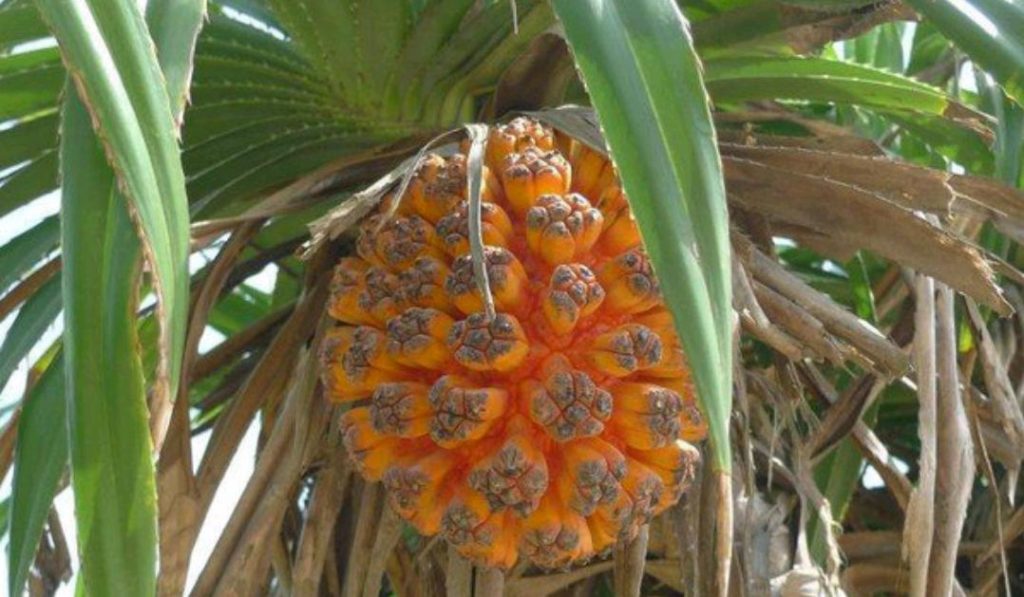Pandanus Tectorius seed

Creating a striking landscape effect wherever it is used, Hala, the Hawaiian Screw Pine, creates a tropical landscape effect wherever it is used. It has an open multi-branched silhouette and can grow to 40 foot in height and can spread 12-30 feet. Grown as an exotic landscape specimen in frost-free zones, trees will experience leaf burn at below 28 F.
The Hawaiian Screw Pine is a medium to fast grower and can tolerate light drought, and salt spray. An exotic tropical species from Polynesia that produces a robust, stilt-rooted trunk and a thick densely spiraling crown of mildly spiny light green or often blue-green leaves with very attractive red margins. Screw-Pine has a pyramidal, sometimes irregular, open, but much-branched silhouette, the smooth, stout trunks topped with full, graceful heads of long, thin leaves, three feet long and three inches wide, emerging spirally from stubby branches.Height: 20-40 ft.
Hardiness: USDA Zones 9-11, Minimum Temp – 26 degrees
Full Sun or Light Shade – Plant in fast draining soil.
Sun Exposure: Sun to Partial Shade
Bloom Color: White/Near WhiteCream/Tan,
Blooms all year.
Soil pH requirements: 6.6 to 7.5 (neutral)
7.6 to 7.8 (mildly alkaline)
Other details:
Flowers are fragrant
Requires consistently moist soil; do not let dry out between waterings
Suitable for growing in containers
Danger:
Handling plant may cause skin irritation or allergic reaction
Plant has spines or sharp edges; use extreme caution when handling
The blue-green foliage color adds to the striking nature of this exotic tree. Pandanus tectorius also makes a stunning container plant for indoors or out. The saw toothed leaves are similar to those of a pineapple plant and emerge spirally from the stilt raised trunk to create a spectacular tropical effect. Small plants are tough and easy to grow and will grow for anybody. Striking plant with long sword-shaped leaves produced in a spiral rosette. As a trunk forms the tree will branch to form several heads, eventually giving a very regular conical specimen plant about 40 feet tall and wide if space allows. Suitable for the home or a greenhouse.
Family: Pandanaceae
Genus: Pandanus (PAN-dan-us)
Species: tectorius
Common Names
Hala, Hawaiian Screw Pine
Pandanus
Pu hala
Screw Pine
Alternative Botanical Names
Pandanus chamissonis
Pandanus douglasii
Pandanus menziesii
Pandanus odoratissimus
Potential or Traditional Uses
Fiber
Landscape
Lei (Flower or seed)
medicine
The leaves are edged with small red spines and are used to make mats and baskets in the tropics. The leaves of screw pines have fine hooked spines along the edges. But these leaves are tough which makes them useful for thatching, mats, and baskets. Branches have prominent leaf scars which encircle the stems. Large brace-roots emerge from the trunk several feet above the ground, helping to support the plant. Screw-Pine is capable of reaching 50 feet in height but is not usually seen over 25 feet in USDA hardiness zone 10 and 11, with a spread of 15 feet. Growth rate is slow to moderate, depending upon fertilization and watering schedules, and Screw-Pine is very popular for use as a specimen or container planting. But pines they are not; these odd plants are monocots, related to grasses, orchids, and palms. It is not a true pine tree; it is a member of the Pandanaceae family..
Members of the genus are dioecious; male and female flowers are produced on different plants. Pandanus tectorius trees are either male or female. Female trees produce a large, segmented fruit somewhat resembling a pineapple. Male trees produce large clusters of tiny, fragrant flowers surrounded by white to cream colored bracts. The female flowers are crowded along the flower spike. Each flower gives rise to a fruit, known as a drupe. A drupe is a single seed within a fleshy outer layer. (Cherries and olives are examples of drupes.) One hundred or more drupes, each from a female flower, form the aggregate fruit of the screw pine. These clusters are about 1 foot long and are called hinano in Hawaiian.The flowers of the male tree are 1 inch long and fragrant, surrounded by narrow, white bracts. The female tree produces flowers with round fruits that are also bract-surrounded. The fruits are around 8 inches long and have many prism-like sections, resembling the fruit of the pineapple. Typically, the fruit changes from green to bright orange or red as it matures.
Pandanus tectorius is a small tree growing 20 to 40 feet in height and from 15 to 35 feet in diameter. The trunk is stout and the branches grow at wide angles to it. It has distinctive long blade-like leaves (lau hala) about 2 inches wide and over 2 feet long. Most varieties have spines along the edges and on the midribs of the leaves. Spineless and variegated forms are available. The leaves are spirally arranged towards the ends of the branches and leave a spiral pattern on the trunk when they fall. Pandanus tectorius trees develop support or prop roots (ule hala) at the base of the trunk and sometimes along the branches. It has a stout, wide-branching trunk ringed with many leaf scars.
Screw pines received their common name from the fact that the strap-like leaves are spirally arranged around the branches. They are dioecious; staminate (male) or ovulate (female) flowers are borne on separate plants. The male flowers are noted for their fragrance, the females for their distinctive pineapple-like fruit. Ancient Hawaiians used almost every part of the plant. Pandanus trees provided materials for housing, clothing and textiles, food, medicine, ornament, fishing, and religious uses.As screw pines grow larger, they produce prop roots around the base of trunk. These roots act as anchors and aid in keeping the screw pines upright during times of heavy winds and rain. Pandanus is known for the many thick prop roots near its base which provide support as the tree grows top-heavy with leaves, fruit, and branches. Sometimes, though, the lower trunk is injured and decays, leaving the screw pine standing on its prop roots.
